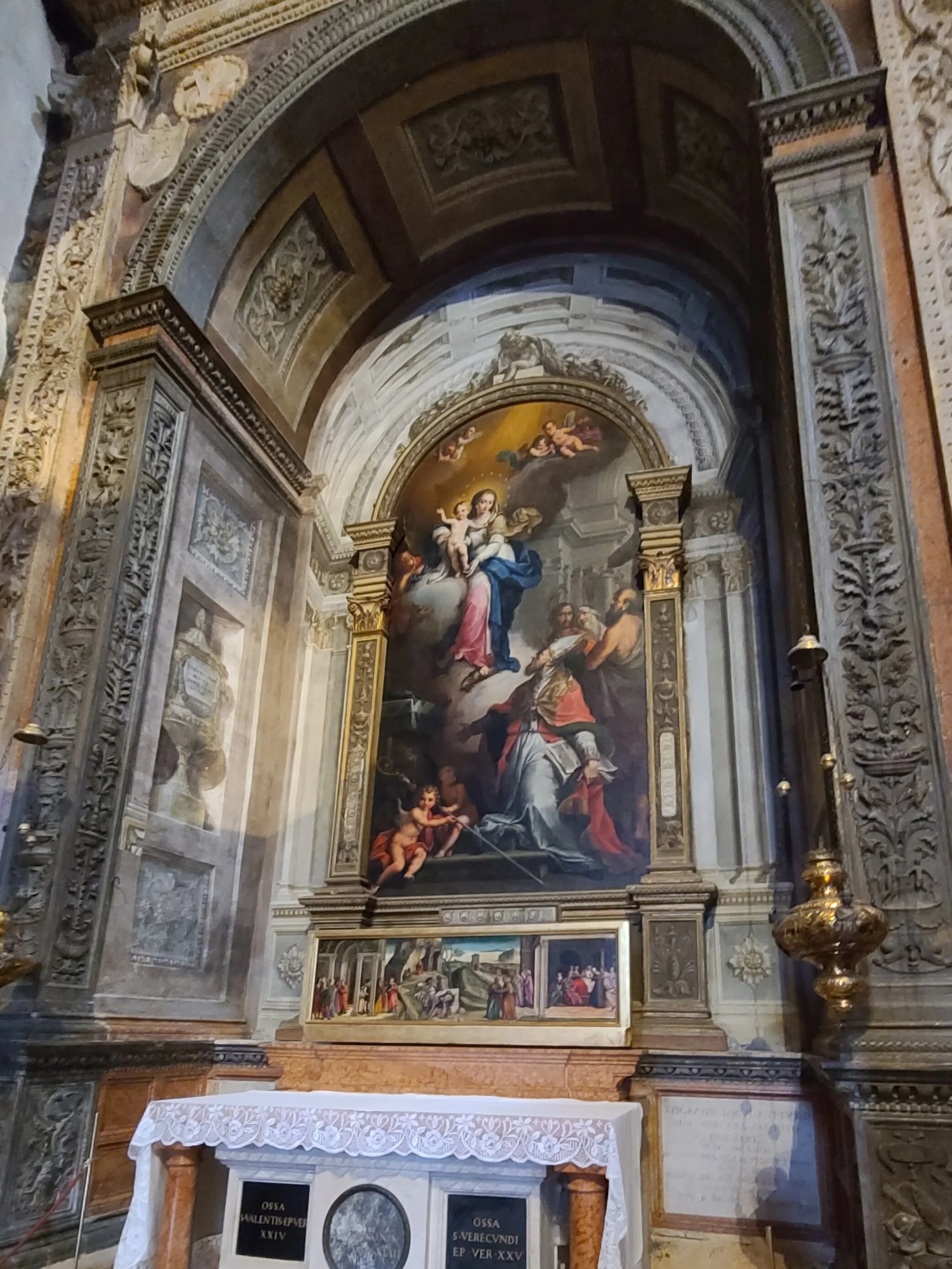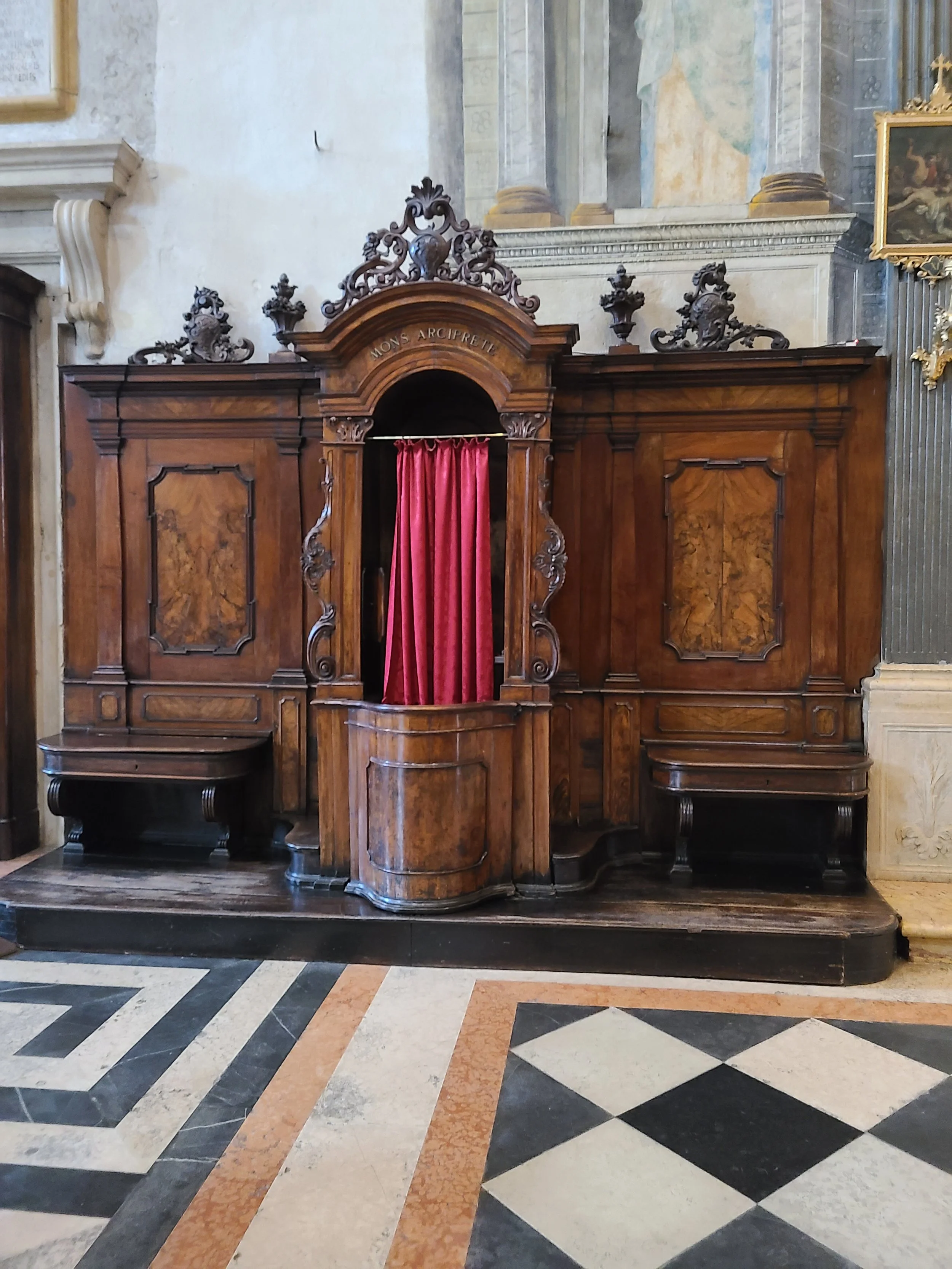The Churches of Verona
I arrived in Verona, Italy in the late morning hours. My hotel room was not yet ready. I left my luggage with the hotel staff and started exploring Verona. Of course, I had a list of places to see. At the top of my list were the four main churches in Verona. I received a Senior Discount Pass for all four churches and started my visit at the Basilica of San Zeno.
I have to say that out of all the churches I have seen so far on this trip, Verona had the best basilicas. They were just spectacular with so much art and history.
The Basilica of San Zeno is dedicated to the patron Saint of Verona.
San Zeno was of African origin and the eighth bishop of Verona from 362-380. To accommodate the large masses of people visiting the small church built on the grave site of San Zeno, the new basilica was built between 805 and 806. This new structure included housing for a community of Benedictine monks. This new basilica was consecrated on December 8, 806. The original basilica was destroyed during military invasions and rebuilt in 963.
An expansion of the structure took place in the 11th century. Between the 1100s and the 1800s, this basilica withstood earthquakes and countless number of renovations.
The front doors of this basilica are an amazing piece of art that consists of different panels depicting stories from both the Old and New Testaments.
I was particularly impressed with the way the fourteen stations of the cross were displayed.
The frescoes throughout the church also tell stories of the lives of the saints.
In each church I visited, the Blessed Sacrament was made known by the red candle lit next to the tabernacle. In this basilica, the tabernacle was part of a side altar in the front of the church next to the main altar.
The main altar in this basilica displayed a six-panel work of art depicting the life of Jesus and Mary.
It is so important in these churches to be sure you look everywhere.
Behind the six-panel artwork on the main altar was a beautiful painting of a bishop. I was unable to find a name for this painting, but it was quite interesting that this artwork would be somewhat hidden.
This basilica had a crypt supported by 54 cross-vaults.
At the end of the crypt, is the burial place of San Zeno.
The beauty of this basilica continued with frescoes on outside walls leading to the cloister area.
The Cathedral Complex was my next stop on my self-guided tour of the churches in Verona. This complex consisted of a cathedral, an ancient church with archeological findings, and a baptistery.
This main cathedral in this complex is also known by the name Saint Maria Matricolare.
Before entering the Cathedral, I visited the baptistery. This was the first time I ever was in a baptistery. It was a beautiful part of the church that had its own point of entry.
It is my understanding from research that the baptistery is a separate structure because in medieval times you could not enter the church until you were baptized. It would be interesting to know if there was someone at the door of the church with a large book checking to see if you’re baptism was listed in the book. There are so many entry points to these large churches that I think it would be an impossible task to ensure the status of all those who passed through the doors.
My next stop in the Complex was the Church of Saint Elena and the archaeological excavations.
This is our Christian history.
It is difficult to fathom what Christians went through during these times. I am grateful for the opportunity to explore our history and to see the beauty created because of the love and devotion for the Father, Son, and Holy Spirit.
As I entered the cathedral, I was once again taken back by the beauty all around me.
These basilicas and cathedrals were built prior to the invention of the printing press. The average person during these times did not read or write. Yet Christianity was important and needed to be known by everyone. The beautiful frescoes, paintings, and statues tell a story and leave an impression on the hearts and minds of those who study them in the same way a good book does for each of us today. I can see the stories of the Old and New Testaments in the artwork throughout these beautiful churches.
As I walked to the next basilica, I noticed a gold plaque on the sidewalk outside a doorway. I knew what this was. I saw this for the first time on an earlier trip in France.
The translation of this plaque is as follows:
Qui Abitava - He lived here
Gilda Forti - Name
Nata 1896 - Date of birth
Arrestata 24.11.1944 - Date Arrested
Deportata - Deported
Ravenshruck - This was a concentration camp for women from 1939 to 1945 located in northern Germany
Assassinata - Murdered
This is truly a reminder that we live in a fallen world. Amid the beautiful Catholic basilicas and cathedrals, we see how humanity has failed. I couldn’t help but stop and say a prayer for Gilda and her family and to whisper an apology for the craziness of this life.
Before long, I was at the third basilica of Verona – the Basilica of Saint Anastasia.
As I enter these magnificent basilicas, I can’t help but wonder who built these ceilings? And how long did it take?
One of the side altars that caught my eye was dedicated to Saint Rose of Lima.
This painting was created in the second half of the 17th century. Saint Rose was born in Lima, Peru and a member of the Third Order of Saint Dominic. She was the first person born in the Americas to be declared a saint by the Catholic Church. Saint Rose is the patron saint of embroiders, gardeners, and florists. I was unable to identify the connection between Saint Rose of Lima and the city of Verona. Perhaps the artist of the painting or the individual who commissioned the painting, had a devotion to Saint Rose and wanted her story to be known by others. It is a beautiful painting and clearly tells of the love and devotion this saint has for God.
Next to the altar dedicated to Saint Rose was the Crucifix Chapel which is the most ancient part of the basilica. The cross dates back to the 15th century.
This is a raised structure and painting of the burial of Jesus and is part of the Crucifix Chapel. The date of completion for this art piece is 1427.
Another side altar named the Centrego Altar is dedicated to Saint Thomas Aquinas. This altar took fourteen years to complete with construction beginning in 1488.
The painting depicts the Blessed Mother and the child Jesus between Saint Thomas Aquinas on the left and Saint Augustine on the right. Both saints are Doctors of the Church and have contributed to the solid foundation of our Christian faith.
The altar dedicated to the Holy Spirit is the Miniscalchi Altar. These paintings created in the late 1400s tell the story of Pentecost.
I can imagine being a resident during that time and going to Mass week after week and watching the beautiful painting unfold before my eyes. It is also possible that the project was kept hidden until it was completed. If that were the case, I would be the one who would try to catch a glimpse.
Here are more beautiful photos of the Basilica of Saint Anastasia.
The next church visited in Verona was the Church of Saint Fermo.
Tradition tells us that in 304, Saint Fermo and Saint Rustico were martyred for their faith. The relics of these martyrs are housed in this church. The original church was rebuilt by the Benedictines in 1065 to 1143. The Franciscans replaced the Benedictines in 1261 and completed construction to many parts of the church. The Franciscans left the church in 1807 following Napoleon’s occupation. The church then became a parish site entrusted to the diocese.
This is a beautiful example of the reconstruction of the artwork in these beautiful churches.
Oh, and look at the cushions on these kneelers!
AMEN & Hallelujah!
Saint Anthony of Padua had a tremendous influence in Verona. Here is an altar dedicated to the Saint of Padua.
The Brenzoni Mausoleum was another beautiful structure that caught my eye. This art piece was constructed in 1426 and tells of the Resurrection of Jesus and the soldiers’ reaction to the resurrection as noted in the Gospel of Matthew.
This church also had a crypt with a vaulted ceiling and a beautiful chapel.
I walked another seven miles in Verona and was on the hunt for gelato. In doing so, I found the Piazza Erbe – a beautiful market area with lots of souvenirs, food opportunities, and GELATO!
Oh, Happy Day!
The next blog will feature more fun in Verona, Italy. Stay tuned!
Use the Amazon buttons below to order your copy of my latest books. Don’t forget to leave a review on Amazon! Thank you and Happy Reading to ALL…..
For my favorite books by other authors - click here.
God Bless and Remember - Sharing is Caring!























































































